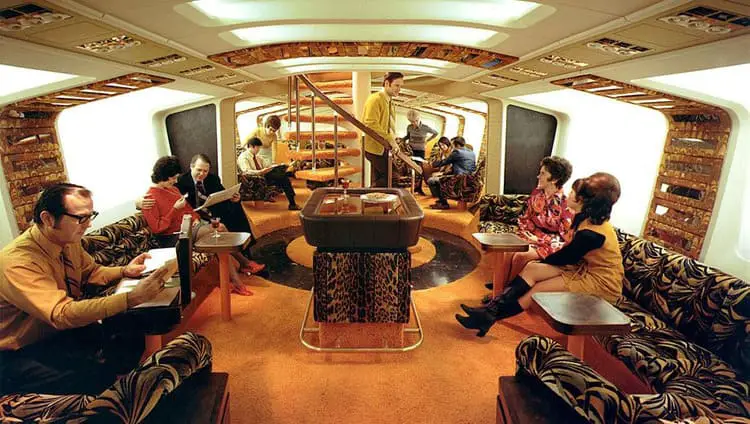If you ever walked onto a Boeing 747 in the 1970s or early 1980s, you might remember something truly special: the curved staircase near the front of the plane.
It didn’t lead to more rows of seats. It led to something magical—a cocktail lounge in the sky.
This is the story of the 747’s upper-deck lounges.
From piano bars to candlelit dining rooms, airlines in the early jet age used these upstairs spaces to create unforgettable experiences.
For many passengers, those lounges weren’t just part of the flight. They were the best part of the journey.
How the Lounge Idea Took Off
When Boeing was designing the very first 747, they planned for it to serve both as a passenger plane and a cargo aircraft.
To make that work, they placed the cockpit above the main deck, creating the now-iconic “hump” at the front of the plane.
This design allowed the nose of the aircraft to swing open for loading freight—but it also left an unexpected bonus: an empty space behind the cockpit.
Instead of letting that area go to waste, Boeing encouraged airlines to get creative with it.
And because this was the golden age of flying—a time when air travel was seen as luxurious and exciting—airlines were eager to impress.
They turned the space into something special.
Some added elegant cocktail lounges and quiet seating areas.
Others went big, installing full-service bars, piano corners, and plush club chairs.
One of the most famous early design concepts was Boeing’s own “Tiger Lounge,” a jungle-themed space with orange seats and walls that looked like fur.
It never flew commercially, but it showed just how imaginative airlines were willing to be.
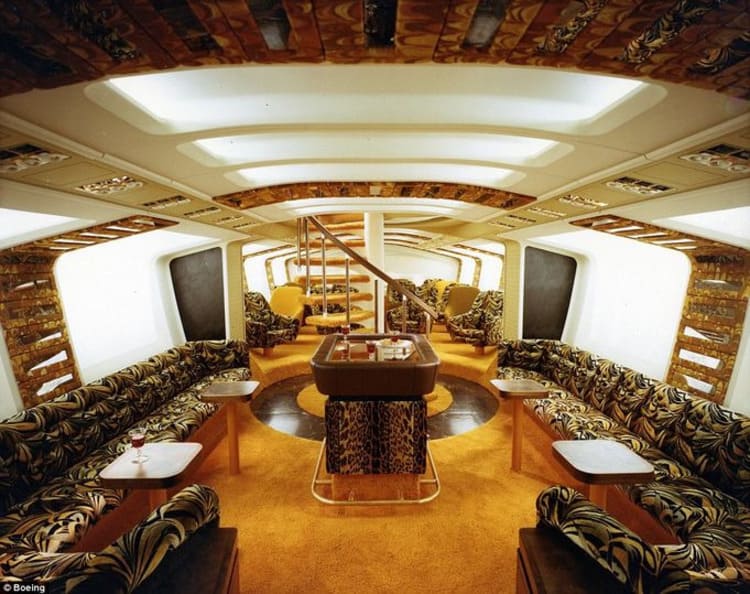
The Iconic Spiral Staircase
The spiral staircase on the Boeing 747 wasn’t just a way to reach the upper deck—it was a statement.
Placed near the front of the cabin, it caught your eye the moment you boarded. It curved gently upward, almost invitingly, as if to say: “There’s something special waiting up here.”
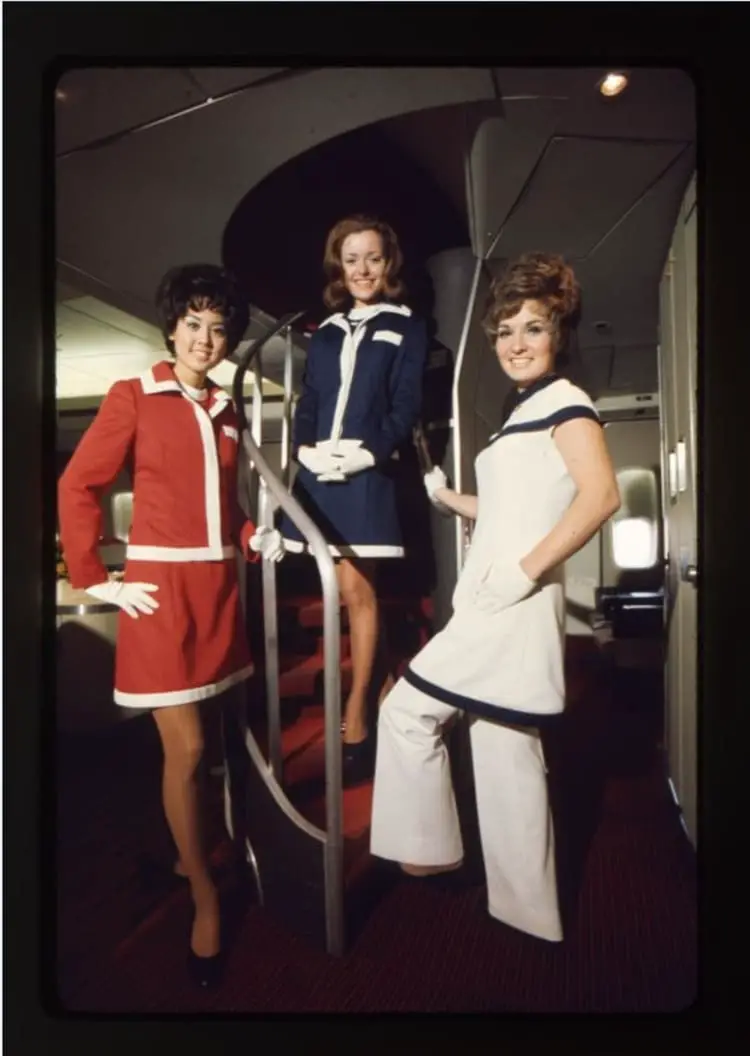
The stairs themselves were designed with style in mind.
Early models featured gold trim along the handrails, soft, deep-pile carpeting, and sometimes even polished brass.
Everything about the design said elegance.
Even the lighting was softer—glowing gently from recessed fixtures, giving the stairs a warm, almost cinematic feel.
Flight attendants recall how passengers would slow down just to admire it, sometimes snapping a quick photo before being ushered to their seats.
For many, especially those flying first class for the first time, climbing those stairs felt like entering a different world: more intimate, more refined, and more luxurious.
It wasn’t just a second floor. It was a floating lounge above the clouds.
And of course, the staircase became a pop culture icon.
It appeared in airline advertisements, postcards, and even TV shows, reinforcing the 747’s image as the queen of the skies.
Today, many aviation lovers say that walking up that staircase remains one of their most unforgettable travel memories.
Pan Am’s Candlelit Supper Club
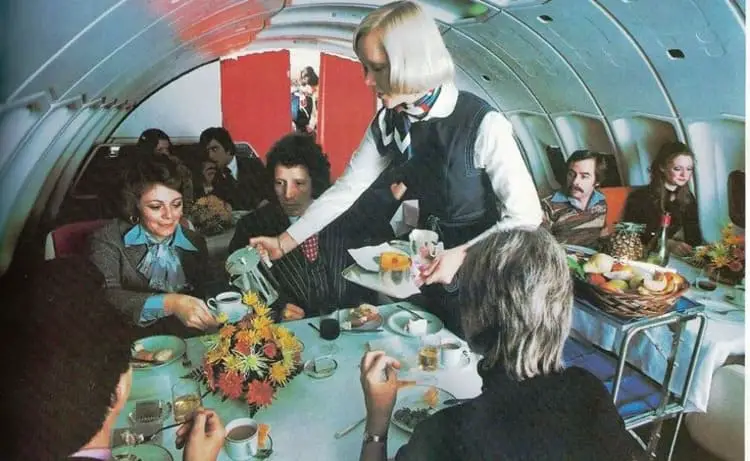
Pan Am, always a trendsetter in international travel, didn’t settle for offering just comfortable seats and fine food.
They took it a step further by turning the upper deck of the 747 into a floating fine-dining restaurant.
After takeoff, first-class passengers were invited to climb the spiral staircase and enjoy a multi-course meal in a setting that rivaled any upscale restaurant on the ground.
The atmosphere was elegant and refined.
Crisp white tablecloths, real china, and gleaming silverware set the tone. Attentive flight attendants served dishes like lobster, prime rib, and chateaubriand—carved tableside, no less.
Dom Pérignon was poured with a smile, and dessert might be something flambéed with brandy.
But it wasn’t just the food. It was the mood.
The dining service only lasted a few years, but for those who experienced it, the memory remains unforgettable.
Qantas and the Captain Cook Lounge
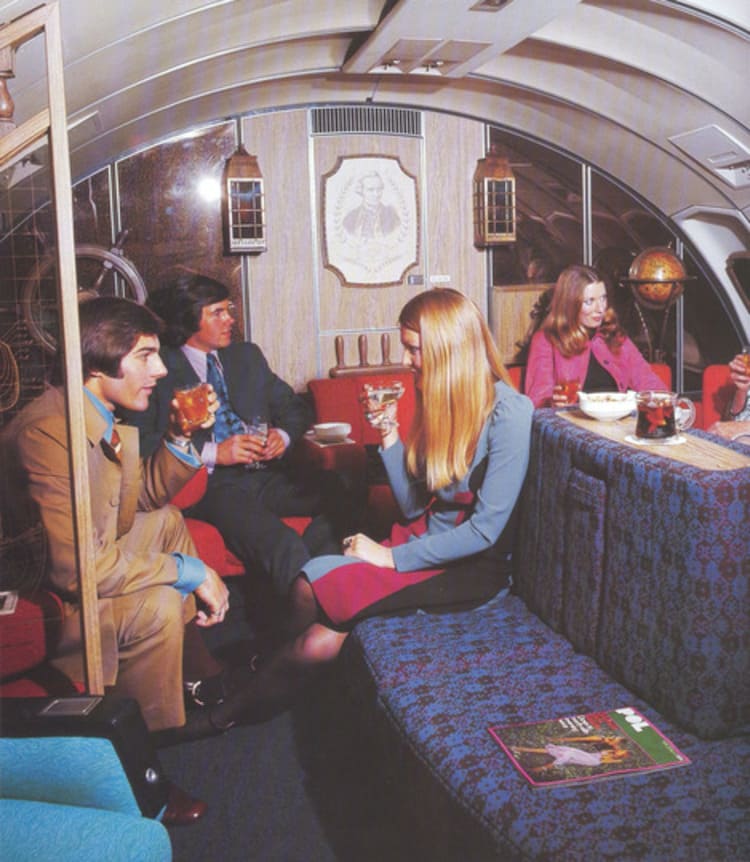
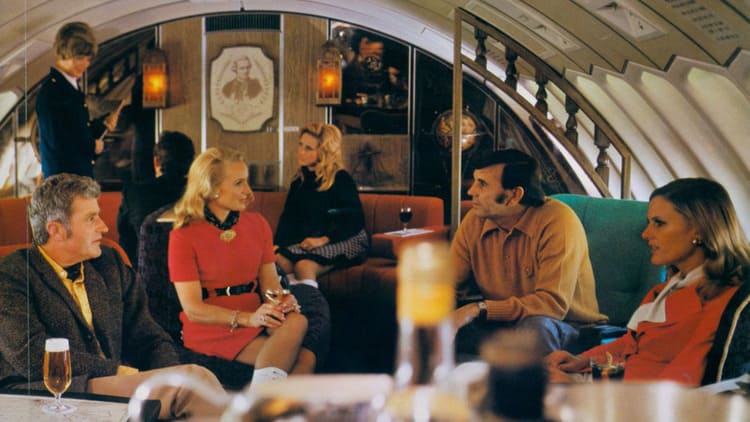
Qantas, Australia’s national airline, gave their 747 upper-deck lounge a unique identity: the Captain Cook Lounge.
It combined mid-century comfort with nautical charm, complete with teak wood accents, brass fixtures, and wall art inspired by maritime exploration.
Stepping inside felt like boarding a luxury yacht suspended in the clouds.
The lounge had a warm, social vibe.
Club-style chairs surrounded coffee tables where passengers gathered to sip cocktails, read newspapers, or chat with fellow travelers.
Drinks flowed from a polished bar, with Australian wines and Bundaberg rum among the top requests.
There was even a “best seat in the house”—a cozy swivel chair by a curved window that gave a wide-angle view of the sky.
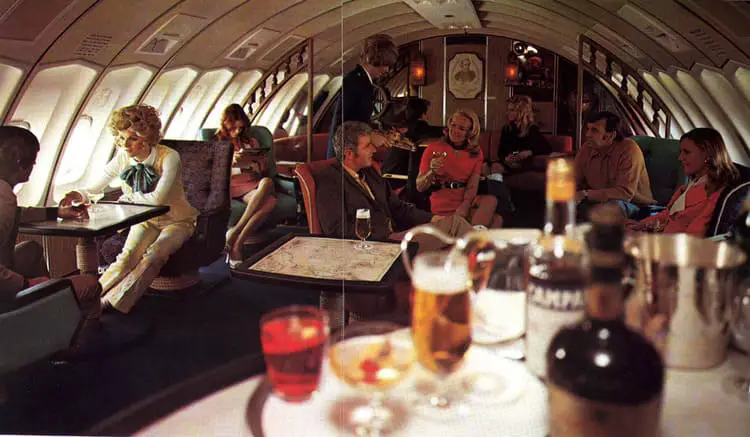
Regular flyers knew about it, and newcomers quickly learned to ask for it. The seat became a favorite for romantic toasts, quiet reflection, and snapping those rare mid-flight photos that made postcards look ordinary.
American Airlines and the Flying Piano Bar
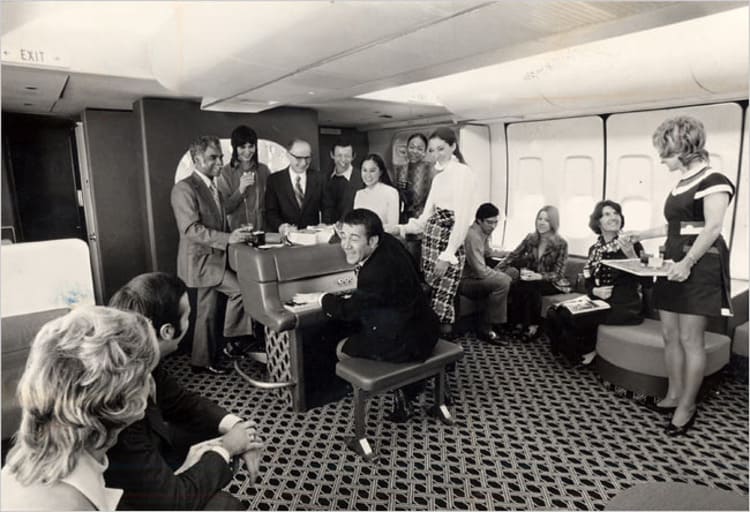
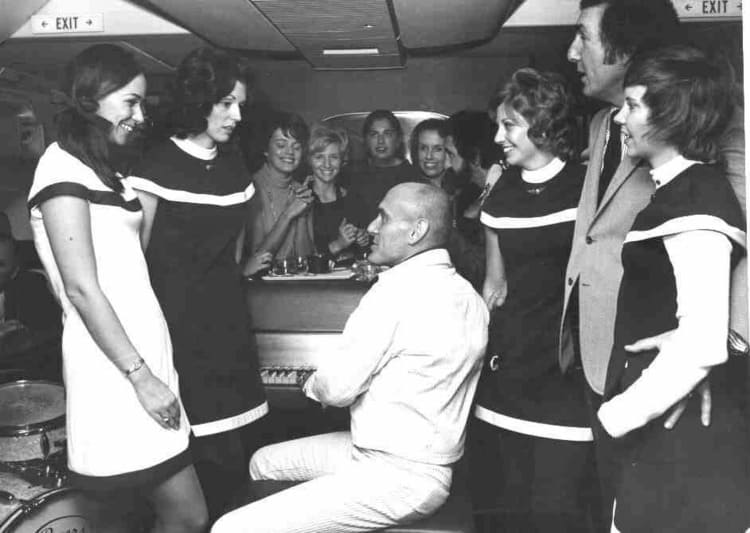
American Airlines embraced the fun side of flying with one of the quirkiest features of any aircraft at the time: a working piano bar.
Located at the rear of the main cabin on early 747s, the space included a curved countertop, padded rail seating, and—amazingly—a Wurlitzer electric organ installed just for in-flight entertainment.
Live music at 35,000 feet wasn’t just a novelty—it was a crowd-pleaser.
The airline hired musicians to perform popular songs mid-flight, often drawing small crowds from the nearby economy section.
Some flight attendants were known to join in for impromptu duets, and passengers sang along to familiar hits like “Raindrops Keep Fallin’ on My Head” or “Fly Me to the Moon.”
The piano bar helped turn long-haul flights into something passengers genuinely looked forward to. It brought people together, created shared moments, and made flying feel special, even in coach.
One former crew member called it “the most joyful place on the aircraft.”
Though short-lived, the flying piano bar remains a favorite memory among travelers who were lucky enough to experience it. It added a touch of magic to air travel that’s rarely seen today.
What Happened to the Lounges?
Unfortunately, these glamorous lounges didn’t last long. In the mid-1970s, the oil crisis hit, and fuel prices soared.
That meant every inch of space on a plane had to justify its existence.
Luxurious lounges, as delightful as they were, didn’t generate revenue the way extra seats did.
- First-class cabins were reconfigured to maximize seating.
- Bars and social spaces gave way to galley areas or were converted into additional rows of premium seats.
- Crew rest compartments also began to occupy that space on long-haul flights.
- The spiral staircases were mostly kept in place, but they now led to quiet, practical business-class sections rather than lively bars or candlelit restaurants.
The magic—of pianos playing mid-flight, of cocktails served under soft lighting, of spontaneous conversations with strangers in the sky—slowly disappeared.
Flying became more about efficiency and less about elegance.
The era of airborne glamour gave way to the age of practicality.
Still, for those who experienced it, the memory of walking up that staircase into a flying lounge remains one of the most special moments in aviation history.
Echoes of the Past
Though the classic 747 lounges are long gone, their spirit lives on.
Some modern airlines, like Emirates and Qatar, have reintroduced onboard bars in their Airbus A380s.
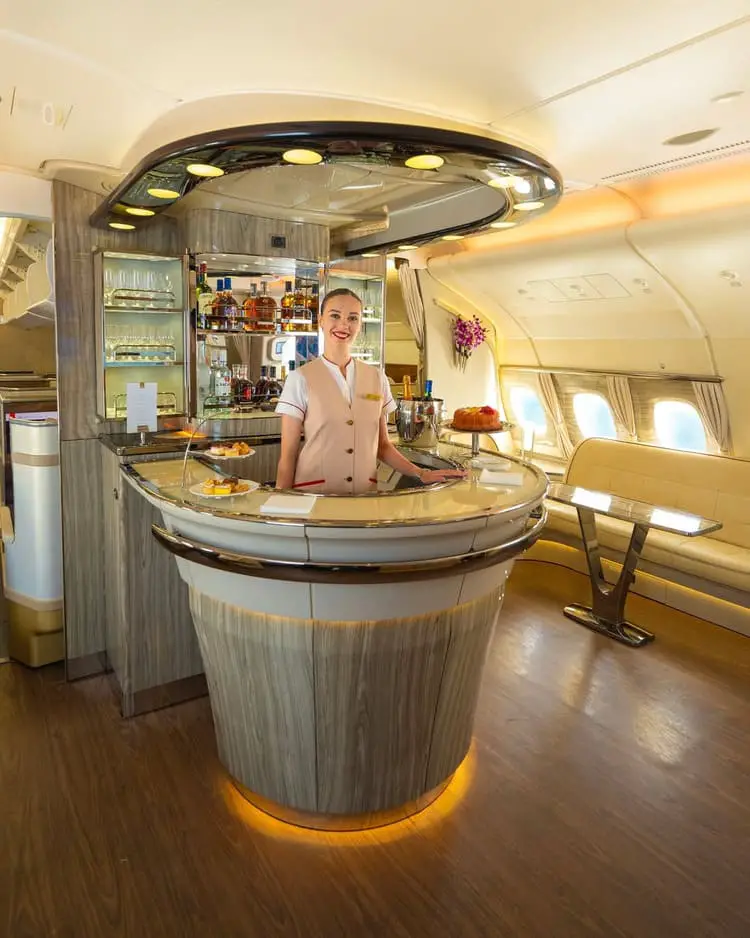
These are sleek, modern spaces—but for those who remember the original sky bars, they don’t quite have the same charm.
There was something about the intimacy of the old lounges, the hush of conversation over the hum of the engines, and the thrill of being in a flying cocktail lounge that modern aircraft can’t quite replicate.
A Final Toast to the Sky Bar
The golden age of 747 lounges may have faded, but its legacy endures in aviation history—and in the memories of those who were lucky enough to experience it.
These airborne sanctuaries represented more than luxury; they reflected a time when flying was something to savor, not just endure. They were designed not merely for transportation, but for delight.
Today, when we see the silhouette of a 747 or glimpse the graceful curve of a spiral staircase in an old photograph, it’s a reminder of what was once possible at 35,000 feet: quiet elegance, a shared drink, and a sky full of wonder.
It was an era of flight that truly soared.
